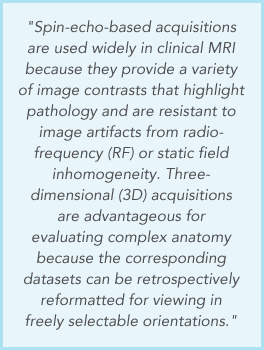|
|
||||
|
November 2015 • Vol. 4, Issue 4 |
||||
| A Message from the SMRT Home Study Educational Seminars Publications Committee | ||||
 |
Anne Marie Sawyer, B.S., R.T.(R)(MR), FSMRT Home Study Program Lucas Center for Imaging Stanford University, Stanford, California, USA T: +1 650 725 9697 E: amsawyer@stanford.edu |
|||
|
MRI Sequences: 3D FSE/TSE and Water-Fat Separation Methods |
||||
|
We are pleased to present the SMRT Educational Seminars, Volume 18, Number 4: “MRI Sequences: 3D FSE/TSE and Water-Fat Separation Methods." This is the 70th accredited home study developed by the SMRT, exclusively for SMRT members. The accreditation is conducted by the SMRT acting as a RCEEM (Recognized Continuing Education Evaluation Mechanism) for the ARRT. Category A credits are assigned to each home study, which can be used to maintain one’s ARRT advanced registry. SMRT Home Studies are also approved for AIR (Australian Institute of Radiography), NZIMRT (New Zealand Institute of Radiation Technology) and CPD Now (The College of Radiographers, United Kingdom) continuing professional development (CPD) activities.
Two previously published, peer-reviewed articles have been chosen for this home study issue. In the first article, Optimized Three-Dimensional Fast-Spin-Echo MRI, the authors begin by stating "Spin-echo-based acquisitions are used widely in clinical MRI because they provide a variety of image contrasts that highlight pathology and are resistant to image artifacts from radio-frequency (RF) or static field inhomogeneity. Three-dimensional (3D) acquisitions are advantageous for evaluating complex anatomy because the corresponding datasets can be retrospectively reformatted for viewing in freely selectable orientations." What follows is an in-depth review including 2D and 3D FSE/TSE acquisitions, RF pulses, power deposition (SAR), artifacts and the effects of varying associated scan parameters. The authors of the second article, Chemical Shift Encoding-Based Water-Fat Separation Methods, focus on various strategies used to separate fat and water signals often used as means to suppress the signal from fat. They introduce their article by saying "Fat in the human body exhibits both relatively rapid longitudinal and transverse relaxation compared to water. The short T1, along with more complicated effects, causes fat to appear bright in images acquire with many common sequences, such as fast or turbo spin-echo (FSE/TSE) and gradient-echo (GRE/FFE) sequences. Hyperintense fat potentially conceals, and generally deteriorates, the depiction of pathology by reducing the dynamic range of notably T2-weighted and contrast-enhanced T1-weighted images. Hence, the signal from fat is routinely suppressed in various MRI examinations." Taking advantage of the differences in resonant frequency between water and fat has led to the development of a variety of methods, some more successful than others, fully explored in this article. A special thank you to Gina Greenwood, MBA, R.T.(R)(MR), FSMRT, from Madison, Wisconsin, USA for acting as the Expert Reviewer. Thanks also to Heidi Berns, M.S., R.T.(R)(MR), FSMRT, Chair of the SMRT RCEEM Ad-hoc committee from Coralville, Iowa, USA and all those who participate on this committee by reviewing the home studies for accreditation. Finally, many thanks to Kerry Crockett, Associate Executive Director, Mary Keydash, Publications Director, Linda O-Brown, SMRT Coordinator, Sally Moran, Director of Electronic Communications and the entire staff in the Berkeley, California, USA office of the ISMRM and SMRT for their insight and long hours spent supporting these educational symposia. |
||||
|
Click here to continue to the SMRT Online Education website. |
||||
|
Signals is a publication produced four times per calendar year by the International Society for Magnetic Resonance in Medicine for the benefit of the SMRT membership and those individuals and organizations that support the educational programs and professional advancement of the SMRT and its members. The newsletter is the compilation of editor, Julie Strandt-Peay, BSM, RT (R)(MR) FSMRT, the leadership of the SMRT and the staff in the ISMRM Central Office with contributions from members and invited participants. |
||||

 Two previously published, peer-reviewed articles have been chosen for this home study issue. In the first article, Optimized Three-Dimensional Fast-Spin-Echo MRI, the authors begin by stating "Spin-echo-based acquisitions are used widely in clinical MRI because they provide a variety of image contrasts that highlight pathology and are resistant to image artifacts from radio-frequency (RF) or static field inhomogeneity. Three-dimensional (3D) acquisitions are advantageous for evaluating complex anatomy because the corresponding datasets can be retrospectively reformatted for viewing in freely selectable orientations." What follows is an in-depth review including 2D and 3D FSE/TSE acquisitions, RF pulses, power deposition (SAR), artifacts and the effects of varying associated scan parameters.
Two previously published, peer-reviewed articles have been chosen for this home study issue. In the first article, Optimized Three-Dimensional Fast-Spin-Echo MRI, the authors begin by stating "Spin-echo-based acquisitions are used widely in clinical MRI because they provide a variety of image contrasts that highlight pathology and are resistant to image artifacts from radio-frequency (RF) or static field inhomogeneity. Three-dimensional (3D) acquisitions are advantageous for evaluating complex anatomy because the corresponding datasets can be retrospectively reformatted for viewing in freely selectable orientations." What follows is an in-depth review including 2D and 3D FSE/TSE acquisitions, RF pulses, power deposition (SAR), artifacts and the effects of varying associated scan parameters.